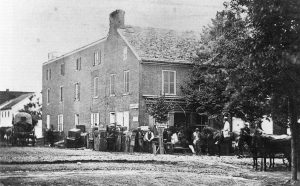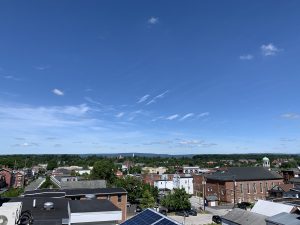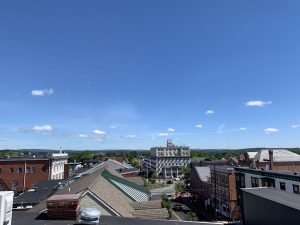Gettysburg Off the Beaten Path: The Fahnestock Building

The average visitor to the Gettysburg battlefield often overlooks the town itself. While the battlefield proper is chock-full of stories and compelling sites, downtown Gettysburg contains a plethora of fascinating stories, too. From sharpshooters and barricades in the streets to the Confederate occupation of the borough, the town of Gettysburg was caught in the throes of war beyond the first three days of July.
One of the most important buildings during and after the Battle of Gettysburg is the Fahnestock Building. The Fahnestock Building is a three-story brick edifice located at the intersection of Baltimore & West Middle Street in Gettysburg. Built circa 1810 and the structure operate for some time as a tavern. The building was purchased by Samuel Fahnestock in 1833, and he promptly opened the “Samuel Fahnestock Store.” The business changed names over time to the “Samuel Fahnestock & Sons Store,” and then finally the “Fahnestock Brothers Store.” Samuel Fahnestock was one of the wealthiest men in Gettysburg when he died at age 64 in 1861. His three sons—James, Henry, and Edward—continued to run the business after Samuel’s death. In 1863, the Fahnestock Brothers Store was a dry goods store—the largest store in the town—in the heart of the bustling Baltimore Street business scene, and the brothers were all successful businessmen and property owners in their own right. During the battle, only James and Henry were in the town. The third brother, Edward, was at that time serving in the Union Army as part of the 165th Pennsylvania Infantry, a nine-month regiment attached to the 7th Corps in the Department of Virginia.
On the morning of July 1st, 1863, the Battle of Gettysburg took shape west of the town. The sounds of battle could be heard, and Union soldiers marched into the streets. Some citizens took to the town’s rooftops with hopes of catching a glimpse of the action. A number of civilians were atop the Fahnestock Building, which boasted an 8 foot by 8 foot observatory on the western rooftop. One of those civilians clambering to a rooftop was 18 year old Daniel Skelly. Skelly worked in the Fahnestock store as a clerk. According to Skelly,
“We could then hear distinctly the skirmish fire in the vicinity of Marsh Creek, about three miles from our position. Shot and shell began to fly over our heads. Being anxious to see more of the battle, I concluded I would go up on the observatory on the store building of the Fahnestock Brothers, situated on the northwest corner of Baltimore and West Middle Streets, and just across the street from the court house.”
The battle was growing in size and intensity as Confederates assaulted the Union 1st Corps positions west of the town. Approaching the town from the south was Federal 11th Corps commander Maj. Gen. Oliver Otis Howard. The “pious but vapid” Howard was a native of Maine and a graduate of both Bowdin College and the United States Military Academy at West Point (1854). Nicknamed “old prayer book,” and described by Col. Charles Wainwright as “the only religious man of high rank that I know of in the army, showed himself the most polished gentleman I ever met.” What Howard lacked in brains he more than made up for in manners and bravery. He often led from the front, and while he lost an arm at the Battle of Fair Oaks in 1862—he earned the Medal of Honor for his actions in the battle.

Howard arrived in the vicinity of Gettysburg sometime before 10 AM. He and his staff familiarized themselves with the ground south of town. Howard, like 1st Corps commander Maj. Gen. John F. Reynolds grasped the importance of Cemetery Hill as a potential fall back position. The one-armed general and some of his staff members rode into the town in search of a vantage point to observe the growing battle, and to better understand the terrain to the west, north, and east of the town.
The town was filled with many useful vantage points that were utilized by both sides throughout the battle. Cupola’s, a clock tower, and rooftops offered just some observation posts to the armies. Howard arrived at the Adams County Courthouse. The structure was built in 1859 along Baltimore Street, the prior courthouse had sat in the town diamond (square). The clock tower of the brick building should have served as a great vantage point, but the door to the belfry was locked. Across Middle Street sat the Fahnestock Building, and young Daniel Skelly “observed General Howard and his staff coming down Baltimore Street from the south of the town. I went down and told them that if they wished they could go up on the observatory of the store building.” Howard and his staff climbed the three stories up to the rooftop observatory, and “with his field glass, made a careful survey of the field west and northwest of the town; also of the number of roads radiating like the spokes of a wheel from the town.”
Sometime around 10:30 AM, Capt. Daniel Hall arrived in the street below the Fahnestock Building and bellowed “General Reynolds is dead, and you are the senior officer on the field.” Atop the Fahnestock Building Howard assumed the role of Left Wing Commander of the Army of the Potomac, which consisted of the 1st, 3rd, 11th Corps, and John Buford’s division of cavalry. Howard sent a flurry of messages to his new subordinates, and to army headquarters informing Maj. Gen. George G. Meade of the situation. Howard then left the building (sort of like Elvis), and established his headquarters on Cemetery Hill, directing the much of the first day’s battle from that vantage point.

By 5 PM, Gettysburg was under Confederate occupation. The mainline of Confederate resistance ran east to west along Middle Street, adjacent to the Fahnestock Building, with sharpshooters and skirmishers farther south in the town beyond High Street. That evening, Mrs. Fahnestock, who lived in the building, received a visitor. The visitor was a Confederate soldier, a nephew, who was serving in Jubal Early’s division.
On July 8th, the United States Sanitary Commission took over the Fahnestock Building to use as their “store house.” The building was filled from floor to ceiling with food, clothing, medicine, and other goods. These supplies were used to feed and care for soldiers and civilians alike due to the burden placed on the army and local supply systems because of the battle and the influx of more than 165,000 soldiers, tens of thousands of animals, and then the army of do-gooders who arrived to help in the days following the epic struggle. By July 25th, the Fahnestock Building was back in the hands of the family, and on July 28, 1863, Edward Fahnestock was mustered out of the army. And life went back to a new normal in Gettysburg. Visitors to the battlefield often passed the building on their way to and from the train station, or while riding along the trolley line that ran along Baltimore Street in the 19th and early 20th centuries. In 1902, Oliver Otis Howard returned to Gettysburg for the dedication of the Henry Slocum monument. During that visit, Howard met up with Daniel Skelly, and the two climbed to the rooftop of the Fahnestock Building where they had their picture taken together.

By the 1980s, the building had fallen into disrepair. In 1984, the building was extensively renovated and converted into senior citizen housing. While the building is private property today, the American Battlefield Trust gained access to the building with the help of Tim Smith of the Adams County Historical Society, and the permission of the Adams County Housing Authority.
To Reach the Fahnestock Building (Today Known as Fahnestock House):
From the town square.
-Walk one block south along Baltimore Street. The building is on the right-hand side o the streets you head south, at the intersection of Baltimore and West Middle Streets.
The building is private property, please DO NOT try and enter the building. Please admire the structure from the outside and see the Fahnestock Building interpretive sign along Baltimore Street.

So many stories in so little a space. (Since 99% of us will never get to visit the top of this building, would be nice if the small photos were expandable–at least I can’t view larger images).
Thank you for this article. I always wondered what the view from the roof would look like and your photos have answered that question.
My maternal grandmother’s maiden name is Fahnestock and I have direct lineage back to the original Fahnestocks in Gettysburg, so on my first visit to Gettysburg recently I was thrilled to see and learn about the Fahnestock building. Thanks for this information!